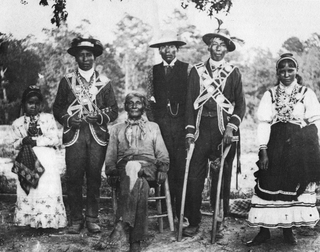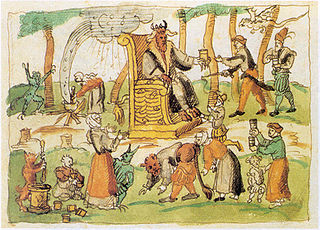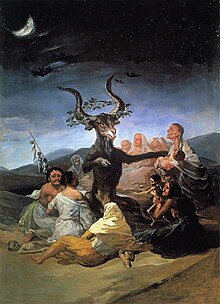
Choctaw mythology is part of the culture of the Choctaw, a Native American tribe originally occupying a large territory in the present-day Southeastern United States: much of the states of Mississippi, Alabama, and Louisiana. In the 19th century, the Choctaw were known to European Americans as one of the "Five Civilized Tribes" even though controversy surrounds their removal.

A Witches' Sabbath is a purported gathering of those believed to practice witchcraft and other rituals. The phrase became especially popular in the 20th century.

The mythology of the ancient Basques largely did not survive the arrival of Christianity in the Basque Country between the 4th and 12th century AD. Most of what is known about elements of this original belief system is based on the analysis of legends, the study of place names and scant historical references to pagan rituals practised by the Basques.

Akelarre is the Basque term meaning Witches' Sabbath. Akerra means male goat in the Basque language. Witches' sabbaths were envisioned as presided over by a goat.

Mari, also called Mari Urraca, Anbotoko Mari, and Murumendiko Dama is the goddess of the Basques. She is married to the god Sugaar. Legends connect her to the weather: when she and Maju travel together hail will fall, her departures from her cave will be accompanied by storms or droughts, and which cave she lives in at different times will determine dry or wet weather: wet when she is in Anboto; dry when she is elsewhere. Other places where she is said to dwell include the chasm of Murumendi, the cave of Gurutzegorri (Ataun), Aizkorri and Aralar, although it is not always possible to be certain which Basque legends should be considered as the origin.
In Basque mythology, Gaueko is the spirit of the night. He does not allow humans to do certain works outside the house during the night. He especially punishes all those who try to show off as brave in the night, boasting of not fearing the darkness. He is considered to be a devil in some accounts, a jentil or gentilic divinity in others. In some cases he makes his presence felt as a gust of wind, as he pronounces these words: Gaua Gauekoarentzat, eguna egunezkoarentzat. Sometimes he appears in the shape of a cow, sometimes in that of a monster.

In Basque mythology, Basajaun is a huge, hairy hominid dwelling in the woods. They were thought to build megaliths, protect flocks of livestock, and teach skills such as agriculture and ironworking to humans.

Zugarramurdi is a town and municipality located in the province and autonomous community of Navarre in northern Spain. It passed into history as the setting of alleged occult activity featured in the infamous Basque witch trials held in Logroño in the seventeenth century. The town is home to the Basque witch museum and the Witch Caves. Every year, spectacular fires are lit in the caves near Zugarramurdi for the celebration of the ‘day of the witch’ on the summer solstice.

Tartaro, Tartalo, or Torto in Basque mythology, is an enormously strong one-eyed giant very similar to the Greek Cyclops that Odysseus faced in Homer's Odyssey. He is said to live in caves in the mountains and catches young people in order to eat them; in some accounts he eats sheep also.
Sorginak are the assistants of the goddess Mari in Basque mythology. It is also the Basque name for witches, priests and priestesses, making it difficult to distinguish between the mythological and real ones.
The Warlocks of Chiloé are people of Chiloé Archipelago said to practise witchcraft linked to Chilote mythology. The warlocks may be real, purported or legendary persons. The source of the witchcraft is often attributed to a legendary encounter between Basque navigator José de Moraleda y Montero and Huilliche machi Chillpila who defeated Moraleda in a duel of witchcraft obtaining a book of European magic as reward. Belief in witchcraft has been common in the archipelago reaching such influence, that in 1880 Chilean authorities put on trial warlocks said to rule the archipelago through a secret society.

Axlor is a prehistoric archeological site in the village of Dima in Biscay in the Autonomous Basque Community of Spain, dating from the Middle Paleolithic or Mousterian period.

The Basque witch trials of the seventeenth century represent the last attempt at rooting out supposed witchcraft from Navarre by the Spanish Inquisition, after a series of episodes erupted during the sixteenth century following the end of military operations in the conquest of Iberian Navarre, until 1524.
In the historical folklore of Sicily, Doñas de fuera were supernatural female beings comparable to the fairies of English folklore. In the 16th to mid-17th centuries, the doñas de fuera also played a role in the witch trials in Sicily.

Alonso de Salazar Frías has been given the epithet "The Witches’ Advocate" by historians, for his role in establishing the conviction, within the Spanish Inquisition, that accusations against supposed witches were more often rooted in dreams and fantasy than in reality, and the inquisitorial policy that witch accusations and confessions should only be given credence where there was firm, independent, corroborating evidence. He was probably the most influential figure in ensuring that those accused of witchcraft were generally not put to death in seventeenth- and eighteenth-century Spain. The Spanish Inquisition was one of the first institutions in Europe to rule against the death penalty for supposed witches. Its Instructions of 1614, which embodied Salazar's ideas, were influential throughout Catholic Europe.

Basque: Jose Miguel Barandiaran Aierbe, Spanish: José Miguel de Barandiarán y Ayerbe known as on Joxemiel Barandiaran and Aita Barandiaran, 'Father Barandiaran', was a Basque anthropologist, ethnographer, and priest.

A baserri is a traditional half-timbered or stone-built type of housebarn farmhouse found in the Basque Country in northern Spain and Southwestern France. The baserris, with their gently sloping roofs and entrance portals, are highly characteristic of the region and form a vital part in traditional Basque societal structures. They are also seen to have played an important role in protecting the Basque language in periods of persecution by providing the language with a very dispersed but substantial speaker base.

There are a number of Basque breeds and cultivars. These are domesticated animals that have been bred - or plant species cultivated - for particular traits and features by Basque people in the Basque Country.

The Betizu is a breed of small mountain cattle which live in a semi-feral state in some mountainous parts of the Basque Country in both Basque Country and France. It is classified as an endangered breed by both the Ministerio de Agricultura, Pesca y Alimentación, the agriculture ministry of Spain, and by the Conservatoire des Races d'Aquitaine in France.














